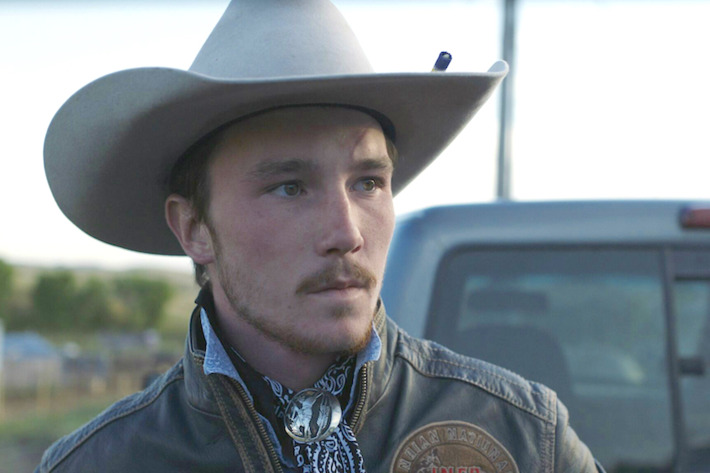By Liz Lopez
Rating: B+
Many people identity themselves by what they do for a living or as a career and are very proud or passionate about it, no matter what the trade or profession. For some individuals, there comes a time and/or a reason they can no longer do what they love – or what they are used to doing and like. In writer and director, Chloé Zhao’s docu-fiction, “The Rider,” the story about Brady Jandreau’s trauma that alters his life completely can feel universal to anyone from anywhere. Most every human being that has had to accept a change, whether a loss of something or someone; will find something to identify with in this well written screenplay. One special feature of this film is that the central cast has not acted professionally before, and it is impressive that none of them provide an amateur performance. The most remarkable of the actors is Brady Jandreau, a member of the Lower Brule Sioux Tribe, in the protagonist role, a 20-year-old Lakota cowboy named Brady Blackburn, a saddle-bronc rider and horse trainer on South Dakota’s Pine Ridge Indian Reservation. Additional performers include his father, Tim Jandreau as Wayne, and sister Lilly Jandreau (as Lily), and they all play fictionalized versions of themselves, as the Blackburn family in this film.
Zhao’s work blends fact and fiction, remaining authentic about life in this Sioux community. The people in the film are proud members of the Lower Brule Sioux Tribe that provide the heart and soul of the filmmaker’s script for “The Rider.” Since childhood, Brady has worked with horses, become a trainer and a saddle-bronc rider that yields him earnings at the rodeos. In the story, the funds help keep the three person family unit afloat, as his father drinks too much and his younger sister has Asperger’s Syndrome. After Brady’s life threatening injuries, his source of income has depleted and despite living in an older model trailer, their living conditions look bleak. Wayne sells his son’s favorite horse, Gus, in order to survive day to day. The scene with Brady having to live through this loss is very authentic and I certainly recall feeling the heartbreak sitting in the theater.
Cinematographer Joshua James Richards returns in the second collaboration with Zhao after her debut feature in 2015, “Songs My Brothers Taught Me.” Richards beautifully captures the Pine Ridge stunning vistas, including Brady’s last ride on Gus. Brady begins to train wild horses again, as he’s done since childhood, building their trust with his intuition and physical stance. Viewers will see Brady’s skill and natural talent in a training scene that is amazing; from the horse’s hostility at the onset and with little dialogue, plenty of skill and body movement, the horse accepts him on its back. Unfortunately, he is risking his life to do this work, yet Brady’s performance reveals the pain from being unable to ride. Zhao and Richards achieve some indescribable beauty that shouldn’t be missed.
There are other moments in the film that that can be wrenching from the emotion. Not only has Brady lost his mama, his best friend Lane (Lane Scott), is a former rodeo star that is permanently paralyzed and speech-deprived, living in a rehab center. Now with both of them injured, the visits mean so much more. I can’t reveal too much, but the story in “The Rider” of a man losing all he really loves will remain with the viewer for more time than will be initially expected.
Filmmaker Chloé Zhao is a SXSW Film Festival 2018 Nominee for the SXSW Gamechanger Award. The film received several nominations at this year’s Film Independent Spirit Awards. At the 2017 Cannes International Film Festival, Directors’ Fortnight, the film won the Best Picture and the director won the International Federation of Art Cinemas (CICAE) award.
=======
During SXSW last month, “The Rider” filmmaker Chloé Zhao was not able to come to the festival and participate in interviews, but I was able to have a brief interview with the film lead, Brady Jandreau in downtown Austin.
Since this was Jandreau’s first time acting, I asked what challenges he could/would provide with his experience. He briefly described that it was “the whole head injury” and his not participating in rodeos – and “not able to ride.” He added that after the injury, he had to manage controlling his emotions. He said he “was an emotional wreck – angry at the wrong times and happy at the wrong times.”
As it is his first film, I asked about his experience working with the filmmaker, to which he responded that he was “very comfortable” with her as “she was stepping in our world” and they with hers. When the cameras would be on, he elaborated about the experience with training the horses. “The connection has to be strong, but complete. Anybody can force a horse – but them wanting to makes a difference.” He also made reference to a dance, adding “you have to make it appealing and comfortable.”
I mentioned to Brady that some of my favorite scenes were with Lane Scott and he fondly spoke of him. “We have been best friends since I was 2 and he was 3. We were always close – inseparable – and rodeoed together, wrestle, (and play) football. He came to Texas on a full ride scholarship. He was hurt in an auto accident and was in a coma for a year.” He added that Lane has been in recovery and was said he would become brain dead, but instead “he was acting.” A ventilator damaged his wind pipe/vocal cords, but he is starting to talk.
What about Brady’s future for more films? He responded that he will pursue acting and he hopes there are more to come. Yes, he has discovered that he can have a connection with horses and the camera.
The film is rated R and will be opening in Austin on Friday, April 27th.
Source: Sony Pictures Classics
